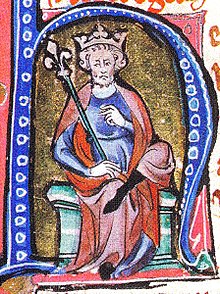BACKGROUND
Karl Cnut was not christened with this name when he was born in 1028. He was christened as Widukind, and he was not supposed to be a King even if both his paternal and maternal families were the most powerful then in Europe.
Widukind was the fourth son of Cnut the Great, King of the Danes, the English and the Norwegians; and his second wife Gunhild, daughter of Ewald II, King of the Saxons and the Franks. However, he was not heir of any crown at the moment of his birth: Cnut had older sons and Gunhild had older brothers. He would be just another Prince with probably no land to claim.
The union of his parents was also not supposed to be the union of their crowns in any way. Cnut had planned to divide his realms between his two older sons born of his first wife Aelfgifu, while the Kingdom of Saxons and Franks already had a co-ruler ready to inherit it, the older brother of Gunhild and future King Ewald III.
Both kingdoms were the main powers in Christian Europe due to the weakness of both Roman Empires. However, while the Kingdom of the Danes was at its top under the reign of Cnut, the Kingdom of the Saxons and the Franks was somehow in decadence since one the mid-10th century.

Cnut the Great, father of Karl Cnut.
The Kingdom of the Saxons and the Franks had formed during the 9th century, when the Saxons took over the Northern Francia. After the death of the great Charlemagne, the former Kingdom of the Franks was permanently divided between his two surviving sons, Pepin and Louis. The later inherited Aquitaine, Burgundy and the Spanish March, while the former received the rest of Frankish realms.
While Louis accomplished the goal that his father had to postpone many times, finally conquering Italy, and thus becoming the newly restored (Western) Roman Emperor, Pepin failed to impose his authority and the anarchy devastated Northern Francia. After Pepin's death, the Saxons took the power and controlled most of the former Frankish realms.
The Kingdom of the Saxons and the Franks reached its top in 934 when Ewald I the Great defeated the Western Romans in Besançon, conquering the northern and eastern parts of Burgundy and ending the Roman influence in the rebellious duchy of Neustria. Unfortunately, after the death of Ewald I, the Kingdom started a period of decadence and some of the realms broke away, while others were lost to the Danes.
In 1028, the Kingdom of the Saxons and the Franks basically comprised the core areas of both nations with some peripheral areas added, as well as the semi-autonomous duchies of Alamannia and Neustria, but part of the later was de facto occupied by the Danes. Parallel branches of the Saxon royals ruled in the Great Moravia and the emerging Kingdom of the Danube, which had pushed Slavs and Hungarians to the east half of the Pannonian plain. These two entities were theoretically vassals of the Kingdom of the Saxons and the Franks, but the ties were loose by then.
The religious conflict between the Popes and the self-proclaimed Patriarchs of the Germanic Church had been destabilizing the Kingdom since 886, when the Archbishop of Cologne assumed this rank himself, with the support of the Saxon elites, which despised the restored Roman Empire. After the defeat of the Romans at Besançon, the divergence between the Saxon-Frankish hierarchy and Rome sharply increased.
The rising Germanic Church had acquired many prestige in England and Scandinavia, but inside the Kingdom of the Saxons and the Franks had caused much division between the traditional Catholics, who defended the supremacy of the Pope, and the supporters of the Patriarch of Cologne. The large Latin-speaking communities in Neustria, Burgundy and southern Alamannia were mostly hostile to the new religious authority in Cologne, as well as the Moravians and the Danubian Germans, and this had pushed all of them to try to separate from the Kingdom and preserve their cult.
Map of Europe in 1028
Last edited:




